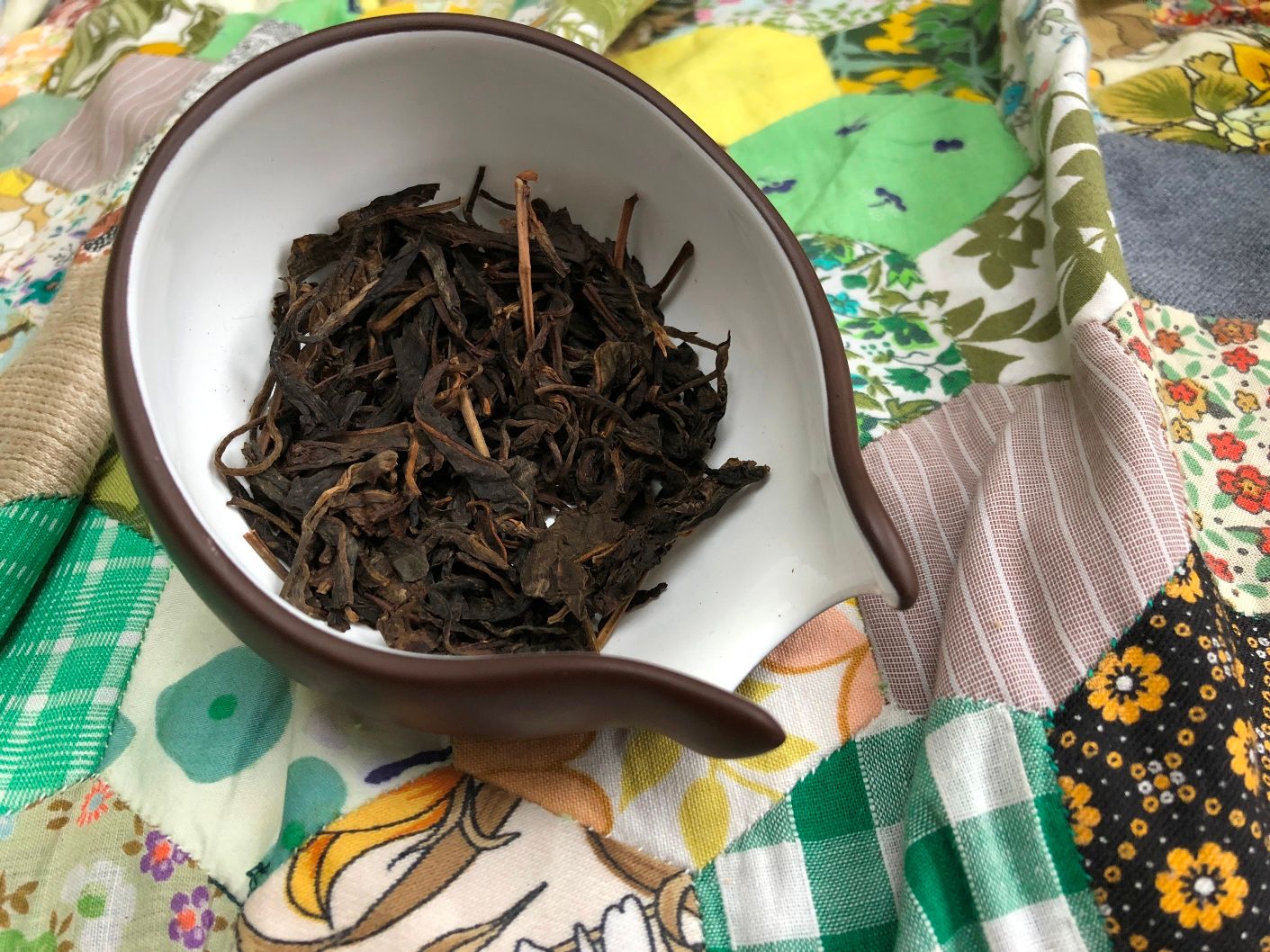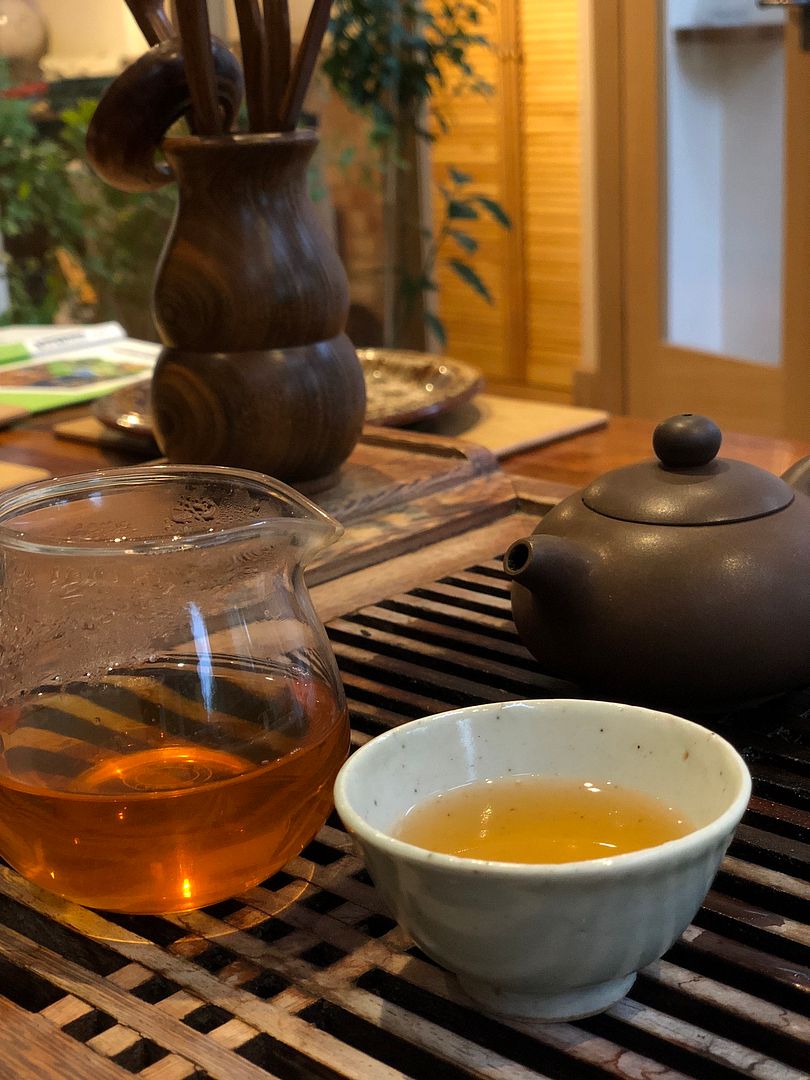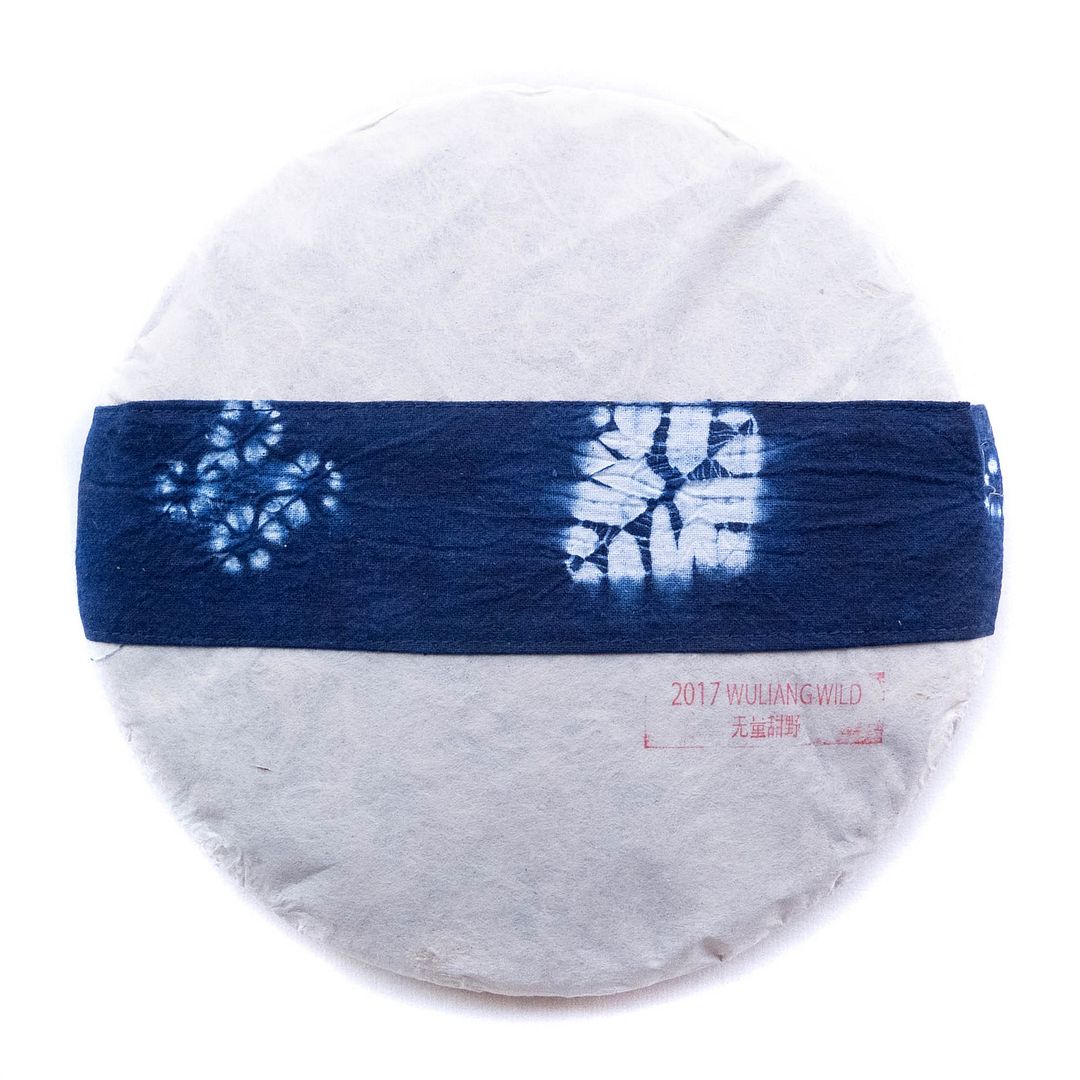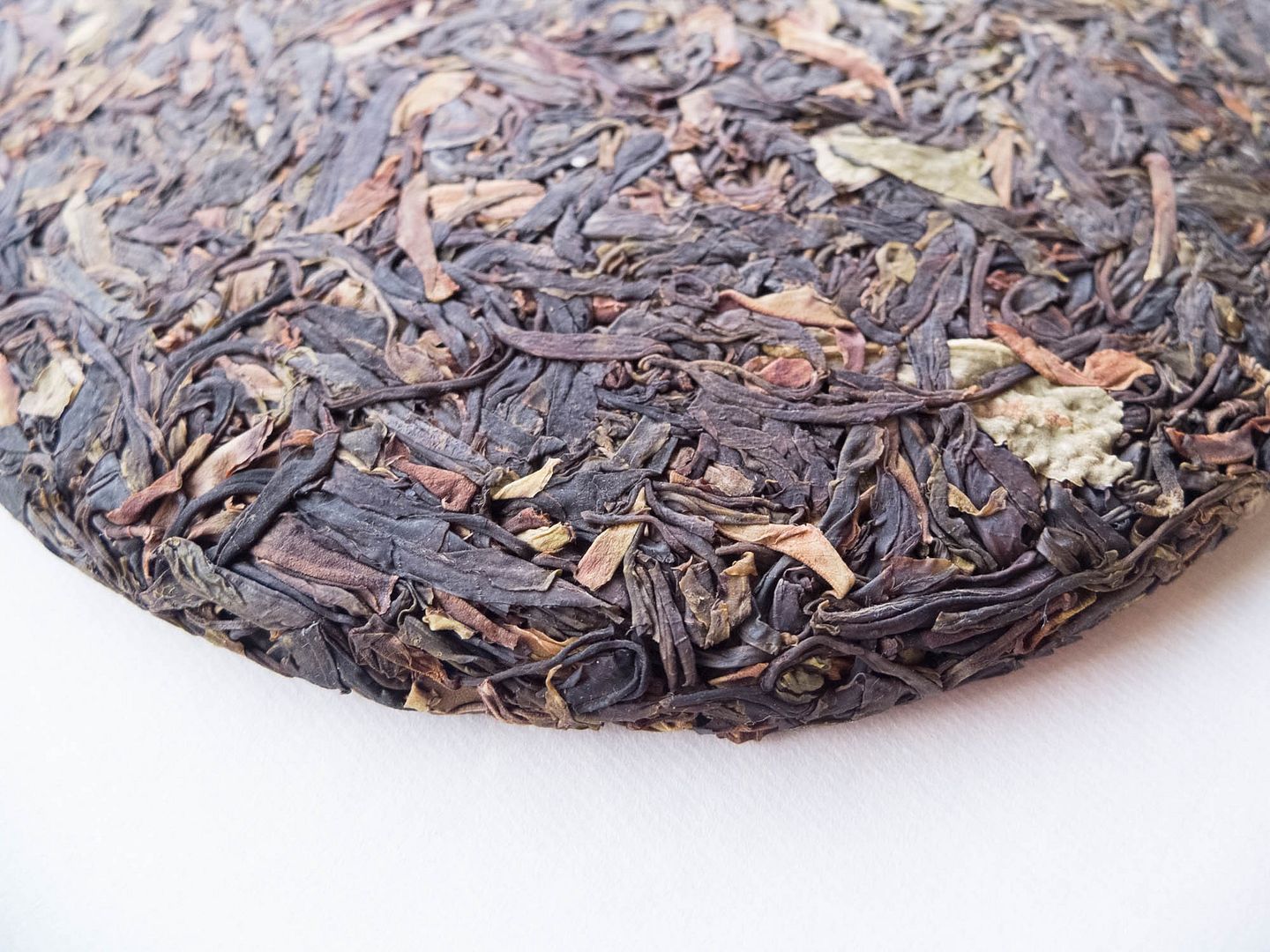Like the ouroboros, I am turning in on myself and drinking a lot of my own cakes of late. This seems almost indecent, after a recent lifetime of continually trying new tea, and continually buying new cakes. However, sufficient time has passed that the game is afoot! Changes are apace.
This article is about two things: (i) cash money, and (ii) aging cakes.
If you've been here since the very beginning, Gentle Reader, or if you've read some of the older articles in the archives, you might remember that I started out writing articles for this humble site when I was but a graduate student. In those benighted days, when my every waking hour was lived within the shadow of The Thesis, I was being paid a "scholarship", which is to say, I was not rolling in disposable income. My university likes to trade on its name, which means it's almost preternaturally disposed to paying far below the going rate at all career levels. You might have experienced the same.
It is ab-so-lutely striking to read some of my old articles, in revisiting my teas, to learn what I considered to be quite a lot of money in those days. For example, check out the two teas below, which I have updated with recent tasting notes:
2007 XZH Longfeng
2006 Douji "Dayeqingbing"
These are cakes that were super, super cheap back in the day, at £23 and £13, respectively, for the 2007 XZH and the 2006 Douji. Taking the more expensive (!) of the two as an example, that £23 in 2007 is now approximately £28 in 2018, via inflation. Back then, as I take great delight in reading, the price was a matter of huge concern. These days, that gets me approximately 30 minutes of swimming class for one (not both) of my young children.
This is not to say that I have become entirely profligate, but merely: how our expectations have changed when it comes to tea-prices! How great is the distance in price between a "solid" cake at £13-£23 pounds and the modern equivalents!
(Note also the important fact that these are proper 357g bingcha, rather than the cheeky xiaobing that are now commonplace, such that vendors can reduce somewhat the effects of the enormously high "sticker price" for a 357g cake.)
Now, I'm not here to punch vendors in the metaphorical ganglia. As with all of us who've been around a little while, it might come as a surprise to learn that vendors are human beings, and that some of them are not (entirely) douchebags. Most of the time. Probably. (Love you, vendorchums.)
I used to take it as a personal insult that someone might want to be remunerated for sweating into their grey knitted underwear up a mosquito-laden mountain in Yunnan, etc. These days, I'm happy to see these folks turning a profit; after all, tea businesses need to be sustainable (i.e., making bank) otherwise there won't be any tea businesses. Heaven forbid we return to the dark days of Houde being the only place to buy tea (love you longtime, Houde).
However, expectations have changed, that much is clear.
The irony is so very, very sweet! When prices were at their most affordable, my budgets were at their least amenable to purchase. Now that personal circumstances have changed, well... you know the price of modern bingcha as well as do I. It's not bad, it just is what it is.
So, prices are higher than they were, such is the outcome of a developed China (always a good thing) and a maturing market for pu'ercha (likewise a good thing). There's not much to be done on that front, except enjoy older tea when we have it.
Hence onto the second aspect of this article: the introspection of a tea writer, disappearing up his own proverbial collection. This is dangerous. I am thus writing about cakes that are quite probably not available any more and, if they are available, might be murderously expensive. Of course, half the fun in the teasphere is the shared experience of trying out cakes together, picking up tips on which one might buy next, and so on. That simply can't happen if some dude starts vanishing into his own shelves.
However, I hope it might be helpful. It's certainly turning out to be extremely instructive for me. The last time that I revisited cakes in any number was around half a decade ago, in 2013, typically much earlier even than that. So, we have a good number of years now from which to make our observations, form hypotheses, and maybe even draw a tentative conclusion or two.
From the above two articles, we might conclude that even quite basic teas (as those above) can do nicely with age. £23 and £13 are not objectively high prices, and the teas were almost certainly from plantations, in my opinion. That plantation character exists within the aged versions, but, like rancid ol' 7542 (which I adore), it has come out well. The raw strength of the early days has smoothed, mellowed, and become elongated into a very substantial sweetness that just continues on and on. The texture is much improved, too: these teas are thick, viscous fluids and they are rewarding. They are not dark teas, but they have the rounded character of sanded and varnished wood, in a good way. I like 'em.
I am also able to draw some conclusions about English storage: as you might have read in the articles above, the sheer dampness of England, and Oxford in particular, is great for keeping these teas "fed" with moisture, such that they don't die. I believe that a lack of humidity is the death knell for pu'ercha, which I understand is commonly-received wisdom. However, British climates are not tropical: we don't have searing heat for much of the year (almost no houses have a.c., for example), and we get high(ish) temperatures for a short part of the year.
(Climate change might have something to say about that! As with most of the world, we're experiencing an unusual heatwave at the moment.)
The cooler temperatures mean that the teas, while staying nicely alive in the humidity, are not accelerating towards redness. Such is the price of not aging one's tea in the tropics. This is something that you can also see from humid-yet-cooler regions of China.
Heresy incoming: I did not choose my place to live based on its capacity to age pu'ercha. I know, what a newb! Thus, I mus live with the consequences. Happily, those consequences seem to be reasonable for tea, in that it's not dying and that it's getting somewhere - albeit slowly. If we are being generous, we might wonder if this is a similar effect to compressing one's tea extensively: tuocha age much more slowly than loose bingcha, of course. As with the prices, it is what it is.
A final conclusion concerns the "black" character beloved of some "house styles", which seems to originate, as far as I can tell, to the mid 2000s. Think of, for example, the recognisable house style of Xiaguan, as typified most clearly in its "FT" range, or, in the extreme, its "Baoyan" products for Tibet (from which perhaps the style originates, given that Baoyan is very much older than the mid 2000s). Douji cakes have a similar, but noticeably different, house style. There is processing afoot such that these teas start a little darker than they might otherwise - and, in the case of Xiaguan, very much more dark. This brings smokiness, richness, and, sometimes, a "tobacco" association.
When these cakes were being processed in this "black" manner, there was not a huge amount of evidence to say how they would age. We have older Baoyan, of course, but most of the FTs, Doujis, and the like come only from the mid 2000s. So, how do they do, after some 12 years?
I rather like the result. The power of youth has smoothed into the sweetness noted before, and the blackness lends a fragrant afterscent that is most complementary, in my opinion. The smokiness has gone, almost entirely, and we are left with dark fruits, old summerflowers, etc. Grab one for yourself and see if you agree.
P.s. Holy smoke: more than 7,000 views for recent articles suggests that the teasphere is very much larger than once it was. Hordes of drinkers, unite!
30 July, 2018
26 July, 2018
Ahoy There
Avast, Gentle Reader!
Good grief, it has been a long time, has it not? To be precise, it has been, checking the sidebar, at least one year since the previous post here at the ol' Half Dipper. Perhaps it is not long in the life of a cake of potent, pugilistic pu'ercha, but it seems significant in duration for mere homo sapiens.
It's been so long, in fact, that I received a message the other day asking, "So what's up with your blog these days?" As you might accurately conclude, the author was from the Americas.
I am writing from a breezy place on the island of O'ahu, which is apparently part of the USA, but which does a very good job of seeming like a lovely little island. I promised myself that I'd set aside a few hours to write to you, Gentle Reader, before I left to rejoin the real world.
So what IS up with my blog these days? I mulled over the question for some time. I fermented and steeped and brewed over the question. I thought it high time that some explanation might be necessary, for any old friends that still inhabit the digital nethers of this strange Interweb, and for newbs alike. After all, are we not all newbs, in the greatest sense?
It took me a while to find my bearings. In the recent year, after swearing the darned things off (successfully) for nearly a decade, I caved in and bought a smartphone, as has become necessary for one part of my life (on which later). The switch from feeds to apps was difficult at first... but now, and I roll my eyes as I write this, I would find it difficult to function, professionally or socially, without my little iProduct.
One of the first baptisms into this brave new world came when I registered for a service that I had, like the smartphone itself, managed to avoid to date:

Instagram seems to be the new teaworld. I like Reddit very much (Mondays would not be complete without gratuitously browsing prequelmemes for half an hour), but this IG thing really seems to be the heart and soul of whatever remains of the teasphere. I like it!
It has its downsides.
I found friends old and new in the IG multiverse, but then came to feel a certain unease. The ephemeral nature of the beast means that something comes and goes before you know it. There is little permanence, by design, of course. This means that, in order to communicate, I observe that one has to be an absolute slut. As in, really very slutty indeed.
Many of my favourite vendors are there, and some new favourites (Crimson Lotus and Bitterleaf Teas seem like tea shops I should visit soon, among others). However, in order to maintain a presence, the level of sluttiness involved is quite substantial. These guys are posting all day, every day - it must be exhausting. Every time I check, there are a few new stories (short videos) and a few new posts from each vendor. The blood pressure on these guys must be sky-high by now! That's some admirable, full-on sluttiness right there.
Perhaps the master of this medium, in the nicest possible way, is the King of Sluts (you knew it all along), Miss Lin at white2tea. It's like late-90s MTV in there as far as I can see, with Miss Lin bestriding them all like a rubber-clad, titanic colossus. There are plenty of challengers for the title, too, with sluts coming out of the woodwork from all angles.
Now, a pro like Miss Lin manages to keep up the quality, because he's been pimping for many years now. However, the intense sluttiness seems to take its toll on those sluts closer to the median on the distribution of digital promiscuity. It's simply very difficult to maintain any level of quality when one is pimping quite so hard. Thus, we have to wade through an infinity of cat videos, dudes attempting to pour tea one-handed (are they gripping their phone in the other hand, or something more sinister?), and so on.
It's not pretty in there.
It is great fun, of course. Never one to shy from a challenge, I found it a medium of good fit for that substrate of strangeness that you have tolerated here for so long: my haiku (or more properly, my haiga, in their combination with an image). It was said of a previous president of the European Union that he was "worryingly professorial, in that he seemed to compose haiku for leisure, and read Shakespeare for fun". This was intended as an insult by the journalist behind the piece, but in me it met with high-fives and exclamations of "my man!" I do both of those things, proudly.
So, come and join me on IG, by doing the clickings of the link below, or by finding half.dipper therein.

So, in the "ghastly private details" part of the post, as promised for my old friends, a quick update to explain the howling abyss that once comprised a pseudo-regular stream of ASCII making its way from my cortex to yours.
It's been brutal, but in a pleasurable way. Kind of like being punched in the face, but with a beautiful boxing-glove, lovingly hand-stitched from silken fibres collected by hand from the polished backsides of selected Chinese silkworms.
These last two months have seen me open a second laboratory in China, funded by the Chinese government (working on AI - are we building Skynet?!), which has been great for acquiring tea, and great for my airmiles balance, but not so great for updates here at the ol' Half Dipper. If you're ever in the Shanghai area, look me up, as there's a relatively high chance I'll be mooching around there with a bunch of similarly pasty "recently escaped from the basement" techie types. Or facedown in a bath of Tsingdao beer, one of the two. This required the smartphone - you can't buy or sell there without the mark of the beast, or at least a smartphone, equipped with a Chinese bank account (which I now have, after a battle) and WeChatPay + Alipay.
My two dudes are now Big Dudes (being 5 and 7 years old, with better Mandarin than their ignorant father). I'm just about to finish a Research Fellowship, have moved into being an Associate Professor ("Ass Prof"!), and was last month offered a Chair. You know academia is an ancient business when a good job is named after a piece of furniture. Finally, the AI company that was set up last year is about to go through its IPO, which is an education in itself.
I'd like to get back to writing you, Gentle Reader, but I must be realistic with my own aspirations. I manage to drink tea (a lot of tea, in fact), because it seems that 95% of my job these days involves sitting in meetings and talking science. This means that I am, more often than not, in close proximity either to my own gongfucha setup in my lab, or near a temporary equivalent that I've snuck into a meeting. My ability to drink is fine - but my ability to write about it is not forthcoming. So let's proceed on that basis.
Come and join me on IG for the interim, and we can take mutual pleasure in watching all our old favourite companies dancing for our delight. And it's not a nice dance, but rather something like a rough, abrasively grinding lapdance.
Encore! Encore!
Good grief, it has been a long time, has it not? To be precise, it has been, checking the sidebar, at least one year since the previous post here at the ol' Half Dipper. Perhaps it is not long in the life of a cake of potent, pugilistic pu'ercha, but it seems significant in duration for mere homo sapiens.
It's been so long, in fact, that I received a message the other day asking, "So what's up with your blog these days?" As you might accurately conclude, the author was from the Americas.
I am writing from a breezy place on the island of O'ahu, which is apparently part of the USA, but which does a very good job of seeming like a lovely little island. I promised myself that I'd set aside a few hours to write to you, Gentle Reader, before I left to rejoin the real world.
So what IS up with my blog these days? I mulled over the question for some time. I fermented and steeped and brewed over the question. I thought it high time that some explanation might be necessary, for any old friends that still inhabit the digital nethers of this strange Interweb, and for newbs alike. After all, are we not all newbs, in the greatest sense?
It took me a while to find my bearings. In the recent year, after swearing the darned things off (successfully) for nearly a decade, I caved in and bought a smartphone, as has become necessary for one part of my life (on which later). The switch from feeds to apps was difficult at first... but now, and I roll my eyes as I write this, I would find it difficult to function, professionally or socially, without my little iProduct.
One of the first baptisms into this brave new world came when I registered for a service that I had, like the smartphone itself, managed to avoid to date:

Instagram seems to be the new teaworld. I like Reddit very much (Mondays would not be complete without gratuitously browsing prequelmemes for half an hour), but this IG thing really seems to be the heart and soul of whatever remains of the teasphere. I like it!
It has its downsides.
I found friends old and new in the IG multiverse, but then came to feel a certain unease. The ephemeral nature of the beast means that something comes and goes before you know it. There is little permanence, by design, of course. This means that, in order to communicate, I observe that one has to be an absolute slut. As in, really very slutty indeed.
Many of my favourite vendors are there, and some new favourites (Crimson Lotus and Bitterleaf Teas seem like tea shops I should visit soon, among others). However, in order to maintain a presence, the level of sluttiness involved is quite substantial. These guys are posting all day, every day - it must be exhausting. Every time I check, there are a few new stories (short videos) and a few new posts from each vendor. The blood pressure on these guys must be sky-high by now! That's some admirable, full-on sluttiness right there.
Perhaps the master of this medium, in the nicest possible way, is the King of Sluts (you knew it all along), Miss Lin at white2tea. It's like late-90s MTV in there as far as I can see, with Miss Lin bestriding them all like a rubber-clad, titanic colossus. There are plenty of challengers for the title, too, with sluts coming out of the woodwork from all angles.
Now, a pro like Miss Lin manages to keep up the quality, because he's been pimping for many years now. However, the intense sluttiness seems to take its toll on those sluts closer to the median on the distribution of digital promiscuity. It's simply very difficult to maintain any level of quality when one is pimping quite so hard. Thus, we have to wade through an infinity of cat videos, dudes attempting to pour tea one-handed (are they gripping their phone in the other hand, or something more sinister?), and so on.
It's not pretty in there.
It is great fun, of course. Never one to shy from a challenge, I found it a medium of good fit for that substrate of strangeness that you have tolerated here for so long: my haiku (or more properly, my haiga, in their combination with an image). It was said of a previous president of the European Union that he was "worryingly professorial, in that he seemed to compose haiku for leisure, and read Shakespeare for fun". This was intended as an insult by the journalist behind the piece, but in me it met with high-fives and exclamations of "my man!" I do both of those things, proudly.
So, come and join me on IG, by doing the clickings of the link below, or by finding half.dipper therein.

So, in the "ghastly private details" part of the post, as promised for my old friends, a quick update to explain the howling abyss that once comprised a pseudo-regular stream of ASCII making its way from my cortex to yours.
It's been brutal, but in a pleasurable way. Kind of like being punched in the face, but with a beautiful boxing-glove, lovingly hand-stitched from silken fibres collected by hand from the polished backsides of selected Chinese silkworms.
These last two months have seen me open a second laboratory in China, funded by the Chinese government (working on AI - are we building Skynet?!), which has been great for acquiring tea, and great for my airmiles balance, but not so great for updates here at the ol' Half Dipper. If you're ever in the Shanghai area, look me up, as there's a relatively high chance I'll be mooching around there with a bunch of similarly pasty "recently escaped from the basement" techie types. Or facedown in a bath of Tsingdao beer, one of the two. This required the smartphone - you can't buy or sell there without the mark of the beast, or at least a smartphone, equipped with a Chinese bank account (which I now have, after a battle) and WeChatPay + Alipay.
My two dudes are now Big Dudes (being 5 and 7 years old, with better Mandarin than their ignorant father). I'm just about to finish a Research Fellowship, have moved into being an Associate Professor ("Ass Prof"!), and was last month offered a Chair. You know academia is an ancient business when a good job is named after a piece of furniture. Finally, the AI company that was set up last year is about to go through its IPO, which is an education in itself.
I'd like to get back to writing you, Gentle Reader, but I must be realistic with my own aspirations. I manage to drink tea (a lot of tea, in fact), because it seems that 95% of my job these days involves sitting in meetings and talking science. This means that I am, more often than not, in close proximity either to my own gongfucha setup in my lab, or near a temporary equivalent that I've snuck into a meeting. My ability to drink is fine - but my ability to write about it is not forthcoming. So let's proceed on that basis.
Come and join me on IG for the interim, and we can take mutual pleasure in watching all our old favourite companies dancing for our delight. And it's not a nice dance, but rather something like a rough, abrasively grinding lapdance.
Encore! Encore!
03 July, 2017
Wuliang Clan
Gentle Reader, before we get down to our mutual camellia sinensis addiction, it would probably be helpful to give you the background to how I approached today's tea. The one informs the other, and it would be giving you a partial assessment were I to attempt to separate the two.
Imagine, if you will bear with me, that you have been born and raised in a cold country. Imagine childhoods spent playing in snow, long winter months of darkness, being wrapped up in heavy clothes for most of the year, and having a runny nose for about 75% of that time. This is what it is like to be English.
Your entire life is predicated on the fact that (i) winter is dark, rainy, and cold; and (ii) summer is, at best, "quite nice". A good summer of memory will hit the low-to-mid 20s, in degrees Celsius (i.e., in the 70s, degrees Fahrenheit). You spend most of your life dressing in "proper" clothes (inc. cardigan), and you might slip into short sleeves for one or two months in the height of summer, to try and cope with those temperatures in the 20s (70s Fahrenheit). Your entire childhood was spent playing sports on frosty ground, acclimatising yourself to being constantly cold.
There is very nearly no air conditioning in the entire country, because it would be unused for most of the year. This fact alone causes tremendous amusement to people from overseas, but there really is very little use for it here.
Now, if you're still with me on this imaginary train of thought, I would like you to imagine what it would be like for temperatures to jump from being 21 degrees C (70 degrees F) on a Tuesday to 32 degrees C (90 degrees F) on the following Wednesday.
Imagine your cold constitution suddenly exposed to this heat - the hottest that it has ever been (since records began 200 years ago) in England at this time of year.
Now imagine yourself wearing a black woollen suit ("subfusc").
Now imagine yourself wearing a white bow tie, tightening around the neck.
And, finally, imagine yourself wearing heavy, scarlet, woollen robes that weigh 10% of your body-weight*.
*At your correspondent's rather lardy 75 kg.
All without air conditioning.
This is Encaenia 2017, and it is f***ing deadly for all concerned.
It is the university marking the end of the academic year, before we go our respective ways for the summer. 200 or so dons assemble in an old, pretty building designed by Sir Christopher Wren, and we sit there for an hour or so while awards are presented in classical Latin; the Professor of Poetry delivers a short homily; and the Public Orator does what seems to be 15 minutes or so of (academic-related) stand-up comedy. Which typically corresponds to taking the p*** out of The Other Place.
Except this year, the temperature. The temperature.
I'm amazed that there were no deaths.
This was the background to cracking open the proverbial cold one with the proverbial boys: the 2017 "Wuliang Wild" from Essence of Tea.
I very nearly don't need the kettle to heat the water today. It is hot, like your mother.
On disrobing my sample, I am struck by what are very red leaves. I am instantly reminded of the recently-described 2017 "Secret Forest Wild Really Secret Wild It's Actually Very Secret". Both cakes are "red". The Super-Secret cake comes from an undisclosed location; today's cake comes from Wuliangshan.
I invite you to check out the cake below where, even under these photographic conditions, you can see redness. Of course, the leaves have the delicious scent of purple fruits.
As ever, this is exceedingly clean and sweet - it is definitely "sweet wild", as Mr. Essence writes, rather than "bitter wild". (I was unaware of the distinction in descriptions of wild trees, but it makes some sense.)
Is the fruitiness from the "sweet wild" nature of the tree itself, or of the manner in which the leaves are treated? My suspicion is that it might be latter (the leaves are red, after all), but this is speculation.
Mr. Essence shows a photograph of a huge tree, reproduced below, which the locals tend to avoid picking in favour of their tea-gardens. We read that aforementioned locals were convinced to climb this extraordinary tree to obtain the leaves for this cake, making it a rather special production.
There is initial fruitiness in the soup, of course, which is not unlike the "Secret Forest Wild" (as linked earlier), but this is much more cooling - it is almost Bingdao in its chilliness. At £76 / 400g, this Wuliang cake is also substantially less costly than the Secret Forest Wild. £76 for a rare picking, with the usual clean panel of lab results, does seem like rather a bargain.
Given the roaring heat, it is charming (and greatly relieving) to drink this now. This is precisely the tea that should be consumed after Encaenia in the heat.
Would it age? It might not be strong enough to age in chilly, damp England, where we need sheer potency to see us through. This is a "sensations" cake, and is almost entirely absent any bitterness.
This is not to say that it is not full - the colour is a solid orange, and the texture is quite chunky. It's a perfect cake for summer, and really energises my tired, fatherly frame. There is a very positive effect on the constitution. Somehow, even though it is not big ol' pugilistic pu'ercha, it makes the mouth water with its payload of mature-tree contents.
I am attempting to avoid likening tea this to the quality of lactation of the more senior age of lady, and will surely spare you the comparison for the sake of decency. You get the idea.
As with the Secret Forest Wild, I will defer in favour of a more orthodox pu'ercha, but will always remember the manner in which this 2017 Wuliang Wild saved me from admission to the Intensive Care Unit, through cooling my constitution and chilling me back to the temperatures that nature intended.
Addendum: for the past week, it has returned to 18 degrees C (65 degrees F), and I am back in my cardigan. This is "summer" as I have been bred to understand it.
Imagine, if you will bear with me, that you have been born and raised in a cold country. Imagine childhoods spent playing in snow, long winter months of darkness, being wrapped up in heavy clothes for most of the year, and having a runny nose for about 75% of that time. This is what it is like to be English.
You think the darkness is your ally; you merely adopted the dark.
I was born in it, molded by it.
I didn't see the light until I was already a man;
by then, it was nothing but blinding!
-- Your average Englishman
Your entire life is predicated on the fact that (i) winter is dark, rainy, and cold; and (ii) summer is, at best, "quite nice". A good summer of memory will hit the low-to-mid 20s, in degrees Celsius (i.e., in the 70s, degrees Fahrenheit). You spend most of your life dressing in "proper" clothes (inc. cardigan), and you might slip into short sleeves for one or two months in the height of summer, to try and cope with those temperatures in the 20s (70s Fahrenheit). Your entire childhood was spent playing sports on frosty ground, acclimatising yourself to being constantly cold.
There is very nearly no air conditioning in the entire country, because it would be unused for most of the year. This fact alone causes tremendous amusement to people from overseas, but there really is very little use for it here.
Now, if you're still with me on this imaginary train of thought, I would like you to imagine what it would be like for temperatures to jump from being 21 degrees C (70 degrees F) on a Tuesday to 32 degrees C (90 degrees F) on the following Wednesday.
Imagine your cold constitution suddenly exposed to this heat - the hottest that it has ever been (since records began 200 years ago) in England at this time of year.
Now imagine yourself wearing a black woollen suit ("subfusc").
Now imagine yourself wearing a white bow tie, tightening around the neck.
And, finally, imagine yourself wearing heavy, scarlet, woollen robes that weigh 10% of your body-weight*.
*At your correspondent's rather lardy 75 kg.
This is Encaenia 2017, and it is f***ing deadly for all concerned.
It is the university marking the end of the academic year, before we go our respective ways for the summer. 200 or so dons assemble in an old, pretty building designed by Sir Christopher Wren, and we sit there for an hour or so while awards are presented in classical Latin; the Professor of Poetry delivers a short homily; and the Public Orator does what seems to be 15 minutes or so of (academic-related) stand-up comedy. Which typically corresponds to taking the p*** out of The Other Place.
Except this year, the temperature. The temperature.
I'm amazed that there were no deaths.
This was the background to cracking open the proverbial cold one with the proverbial boys: the 2017 "Wuliang Wild" from Essence of Tea.
I very nearly don't need the kettle to heat the water today. It is hot, like your mother.
On disrobing my sample, I am struck by what are very red leaves. I am instantly reminded of the recently-described 2017 "Secret Forest Wild Really Secret Wild It's Actually Very Secret". Both cakes are "red". The Super-Secret cake comes from an undisclosed location; today's cake comes from Wuliangshan.
I invite you to check out the cake below where, even under these photographic conditions, you can see redness. Of course, the leaves have the delicious scent of purple fruits.
As ever, this is exceedingly clean and sweet - it is definitely "sweet wild", as Mr. Essence writes, rather than "bitter wild". (I was unaware of the distinction in descriptions of wild trees, but it makes some sense.)
Is the fruitiness from the "sweet wild" nature of the tree itself, or of the manner in which the leaves are treated? My suspicion is that it might be latter (the leaves are red, after all), but this is speculation.
Mr. Essence shows a photograph of a huge tree, reproduced below, which the locals tend to avoid picking in favour of their tea-gardens. We read that aforementioned locals were convinced to climb this extraordinary tree to obtain the leaves for this cake, making it a rather special production.
There is initial fruitiness in the soup, of course, which is not unlike the "Secret Forest Wild" (as linked earlier), but this is much more cooling - it is almost Bingdao in its chilliness. At £76 / 400g, this Wuliang cake is also substantially less costly than the Secret Forest Wild. £76 for a rare picking, with the usual clean panel of lab results, does seem like rather a bargain.
Given the roaring heat, it is charming (and greatly relieving) to drink this now. This is precisely the tea that should be consumed after Encaenia in the heat.
Would it age? It might not be strong enough to age in chilly, damp England, where we need sheer potency to see us through. This is a "sensations" cake, and is almost entirely absent any bitterness.
This is not to say that it is not full - the colour is a solid orange, and the texture is quite chunky. It's a perfect cake for summer, and really energises my tired, fatherly frame. There is a very positive effect on the constitution. Somehow, even though it is not big ol' pugilistic pu'ercha, it makes the mouth water with its payload of mature-tree contents.
I am attempting to avoid likening tea this to the quality of lactation of the more senior age of lady, and will surely spare you the comparison for the sake of decency. You get the idea.
As with the Secret Forest Wild, I will defer in favour of a more orthodox pu'ercha, but will always remember the manner in which this 2017 Wuliang Wild saved me from admission to the Intensive Care Unit, through cooling my constitution and chilling me back to the temperatures that nature intended.
Addendum: for the past week, it has returned to 18 degrees C (65 degrees F), and I am back in my cardigan. This is "summer" as I have been bred to understand it.
Subscribe to:
Posts (Atom)








